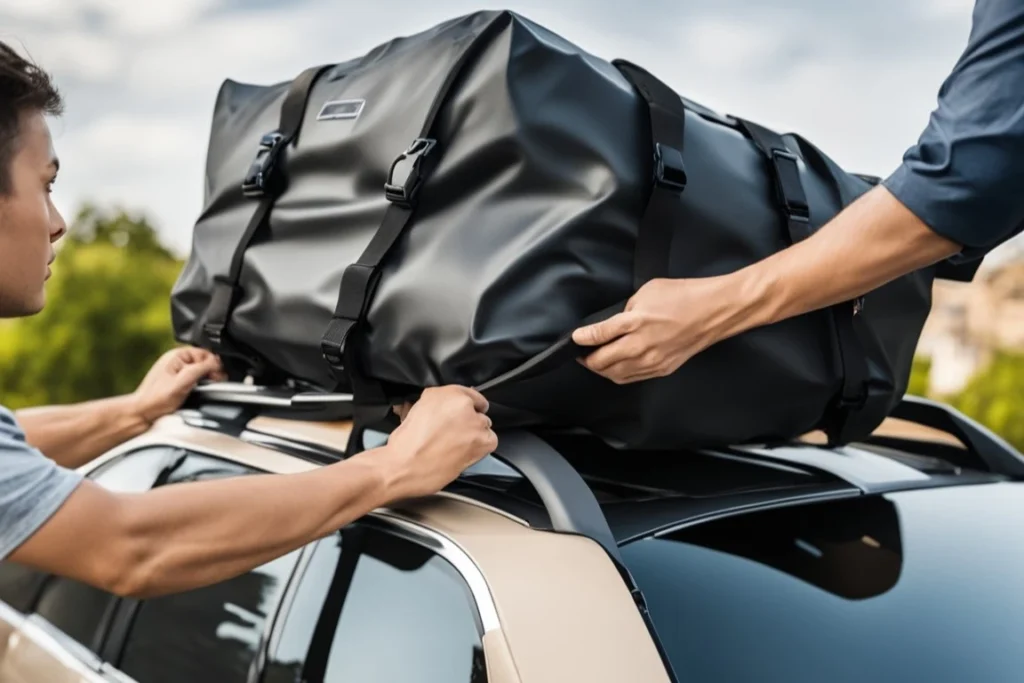If you love traveling, then knowing how to attach cargo bag to roof rack is essential. But if you have just started exploring your traveler self, then in this article, you will surely learn about installing cargo bag easily and safely.
In this article, we will provide you with a complete guide about attaching a cargo bag to roof rack of your ride. But before that, you must choose/ identify your cargo bag type. SO, LETS BEGIN.
Choose/ Identify Your Cargo Bag type
Choosing the right cargo bag type can be challenging, as there are many types of cargo bags. But if you get an idea about the cargo bag types available in the market, the task becomes easy and fun.
So, before we pick a cargo carrier for your vehicle, let’s know the types. Different styles include open-air roof baskets, loose roof bags, and sturdy, watertight roof boxes.
Think about what gear you’ll be packing in your cargo carrier. This will help you decide on the size and whether you need it to keep things dry. Let’s look at the pros and cons of each type to help you choose.
Roof Baskets/Trays
Roof baskets or trays are cargo carriers that provide a stable base for your gear. However, they are open-air, so your gear is exposed to the elements like rain, snow, hail, and ice during your travels. You can use a roof bag that fits securely inside the basket to protect your items.
Roof Bags
Roof bags are compatible with roof baskets or trays. Alternatively, you can secure a roof bag directly to the racks and crossbars using tie-down straps that often come included.
A notable benefit of roof bags is their collapsible nature, allowing for easy storage in compact areas such as garages or closets. However, they can become bulky when packed with gear, impacting aerodynamic efficiency.
Roof Boxes
Undoubtedly, the top choice for a cargo carrier is a roof box. Unlike baskets and bags, roof boxes excel in several aspects. Firstly, they feature a sturdy, hard case design, shielding your gear from harsh weather conditions.
Moreover, roof boxes come equipped with a locking mechanism, ensuring the security of valuable equipment such as gear, firearms, and other belongings. This level of security is unmatched by baskets or bags, which can be vulnerable to tampering or theft.
While roof boxes may have a higher price tag, the initial investment pays off regarding peace of mind and worry-free trips, knowing that your gear is safely protected.
Step by step guide on attaching cargo bag to roof rack
Here in this section, we have provided a complete guide for you to learn about installing cargo bag following the easy ten steps.
Step 1: Prepare the roof rack
Ensure that your vehicle’s roof rack is clean and free of debris. Check that all components of the roof rack, including crossbars and mounting points, are securely attached and tightened according to the manufacturer’s instructions.
Step 2: Position the cargo bag
Place the cargo bag onto the roof rack crossbars, ensuring that it is centered and positioned evenly between the bars. Adjust the placement as needed to achieve a balanced distribution of weight.
Step 3: Open the cargo bag
If your cargo bag features a zipper or other opening mechanism, unzip or open it fully to prepare for loading. Some cargo bags may have a clamshell or roll-top design, so familiarize yourself with how to access the interior space.
Step 4: Load your gear
Carefully load your gear, equipment, or other belongings into the cargo bag. Start with heavier items at the bottom and layer lighter items on top to maintain stability. Be mindful of weight distribution to prevent the bag from becoming unbalanced.
Step 5: Close the cargo bag
Once the cargo bag is loaded, securely close it using the zipper, clips, or closure mechanism provided. Ensure that the closure is fully engaged and that all items are contained within the bag to prevent them from shifting during transit.
Step 6: Attach the straps
Most cargo bags come equipped with integrated straps or tie-downs for securing them to the roof rack. Wrap the straps around the roof rack crossbars and thread them through the designated attachment points on the bag.
Step 7: Tighten the straps
Pull the straps snugly to remove any slack and ensure a tight, secure fit. Pay attention to evenly tensioning the straps on all sides of the cargo bag to prevent it from shifting or sagging during travel.
Step 8: Double-check the attachment
Once the straps are tightened, double-check the attachment to ensure that the cargo bag is securely fastened to the roof rack. Test the stability of the bag by gently pushing and pulling on it to confirm that it remains firmly in place.
Step 9: Secure loose ends
If there are any excess strap lengths after tightening, secure them to prevent them from flapping in the wind or getting caught in moving parts of the vehicle. Some cargo bags may have built-in strap management features to help keep excess straps tidy.
Step 10: Perform a final inspection
Before driving, visually inspect the cargo bag and its attachment to the roof rack one last time. Verify that all straps are securely fastened and that the cargo bag is properly closed and loaded. Additionally, check that all vehicle doors, windows, and the trunk are closed securely.
By following these detailed steps, you can safely and securely attach a cargo bag to your vehicle’s roof rack, allowing you to transport extra gear and belongings with confidence during your travels.
Things to consider when installing cargo bag on roof rack
Before you attach your cargo bag to the roof rack, take a moment to think about some important things. This helps make sure your load is safe and secure, keeping both your stuff and you safe during your trip.
Maximum Weight Capacity of Your Cargo Bag
First and foremost, check the maximum weight capacity specified by the manufacturer for your cargo bag. Exceeding this limit can put strain on your roof rack and vehicle, potentially leading to damage or even accidents. Be sure to distribute the weight evenly to maintain balance and stability.
Tightening the Straps Properly
When attaching the cargo bag to your roof rack, it’s crucial to tighten the straps properly. Ensure that each strap is securely fastened and tightened evenly to prevent the bag from shifting or coming loose during transit. Double-check the tightness of the straps before hitting the road to avoid any surprises.
Testing and Adjusting Before Your Final Drive
Before setting off on your journey, take the time to test the stability of your cargo bag setup. Gently shake the vehicle to simulate driving conditions and check for any signs of movement or instability. If necessary, adjust the straps or load distribution to ensure a secure fit. Performing this test will give you peace of mind and help prevent any issues while on the road.
Final Word
Now you know how to attach cargo bag to roof rack, you are absolutely ready to embark on your journey. Thinking about your safety and comfort we have researched and came up with this guide to make your journey easy and safe. Do share this information with your loved one. Have a happy journey.

